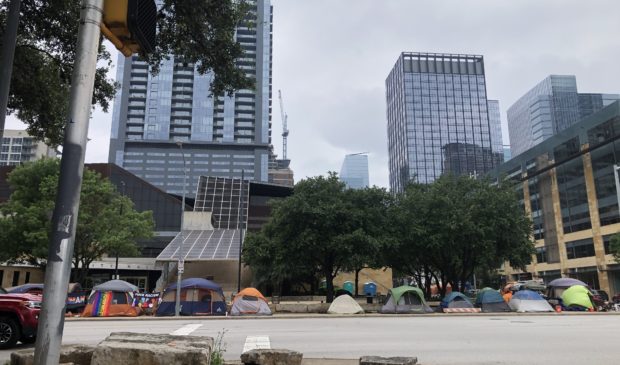Developers, planners key to housing the city’s homeless population
Friday, June 25, 2021 by
Chad Swiatecki City and nonprofit leaders tasked with helping the city’s growing homeless population see a need for short-term temporary housing and longer-term planning strategies that will make it easier to build homes and provide services for those in need.
The ongoing push to update Austin’s building code, the permitting and planning processes and the difficulties caused by neighborhood groups opposed to affordable housing were some of the challenges discussed at Urban Land Institute Austin’s June membership breakfast, which brought together real estate, development and planning professionals at Austin Central Library.
Pressure to address the homelessness issue appears to be growing by the day, with Austin’s median single-family home price rising by $100,000 over the past five months and city leaders forced by a May election to prohibit camping and resting in public places.
With the city and nonprofit groups such as Foundation Communities working to build more affordable housing units, the city’s lead manager on the issue told the room of property owners that more existing units need to be made available for temporary supportive housing.
“While the city supports construction of affordable housing and housing specific to people experiencing homelessness, most of those people will need to be placed in the private rental market,” said Dianna Grey, Austin’s homelessness strategy officer.
“So the partnerships with private property owners and managers are going to be really critical to getting access to placing people back into housing.”
With housing projects of any kind taking years to complete, Foundation Communities Executive Director Walter Moreau said those looking to get people off of the streets need to have patience and a willingness to help.
“The challenge is it takes time to develop a project, three years minimum, so I hope people will be patient. We can solve this problem and it will take time, so we need more short-term emergency solutions.”
Ahead of the May approval of Proposition B that outlawed public camping, an assortment of community groups and agencies held a summit on homelessness that led to a plan to house 3,000 homeless people over the next decade. That plan comes with an expected cost of $240 million, with the city committing $100 million from its American Rescue Plan funding toward the effort.
Grey said Travis County and the private sector will be the main groups expected to take up the rest of the cost and the responsibility to make the plan a reality.
“We are well-positioned to rapidly grow with aggressive scaling, but we need to resource that and very thoughtfully toward concrete unit goals, not only for development but for service capacity, rental supports, and acquiring the units in the rental market as well,” she said. “There’s a (private sector) dollar goal but that isn’t the only way … 3,000 units in a city of our size is not that many, so think about where you sit in the community and industry to find a role to play.”
Other factors playing a role in addressing homelessness include the recent rise in the cost of lumber, concrete and other commodities needed for housing, as well as an ongoing shortage in construction workers in the Austin area.
Melissa Nicewarner Daly, executive director of HomeAid Austin, said the city needs to fix the persistently long permitting process and allow for more dense housing options to add more units and decrease cost pressures.
“The things that hold us back are the same things that you back. It’s construction and things getting stuck in the permitting hole, plans not being approved or getting to be able to expedite the permitting process, waiving impact and permit fees … whatever we can do to grease the skids to move these projects forward,” Daly said.
“It’s going to take courageous leadership and people standing up because the cost of living is far outpacing salaries, and with inflation there is no way to keep up. We need leaders at the top who are able to stand up to NIMBYism, push back and create those inclusive types of architecture that folds beautifully into the landscape of our city.”
The Austin Monitor’s work is made possible by donations from the community. Though our reporting covers donors from time to time, we are careful to keep business and editorial efforts separate while maintaining transparency. A complete list of donors is available here, and our code of ethics is explained here.
You're a community leader
And we’re honored you look to us for serious, in-depth news. You know a strong community needs local and dedicated watchdog reporting. We’re here for you and that won’t change. Now will you take the powerful next step and support our nonprofit news organization?











